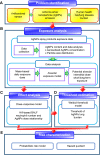Assessing human exposure risk and lung disease burden posed by airborne silver nanoparticles emitted by consumer spray products
- PMID: 30880973
- PMCID: PMC6407905
- DOI: 10.2147/IJN.S171510
Assessing human exposure risk and lung disease burden posed by airborne silver nanoparticles emitted by consumer spray products
Abstract
Background: No systematic investigations have been conducted to assess the lung burden imposed by the chronic inhalation of silver nanoparticles (AgNPs) emitted by spray products.
Objective: The objective of this study was to formulate a study framework that integrates a probabilistic risk assessment scheme with a mechanistic lung burden model for the estimation of health risks associated with the long-term inhalation of AgNP-containing spray products.
Materials and methods: A compartmentalized physiologically based alveolar deposition (PBAD) model was used to estimate AgNP lung burden. Dose-response relationships were established using nanotoxicity data sets obtained from rats (as a model organism). Weibull model-based thresholds of AgNP lung burden based on neutrophil-elevated inflammation bio-markers were estimated from Hill-based exposure-response relationships. Finally, the risks of lung disease posed by various AgNP-containing spray products were assessed.
Results: Conservative thresholds for the prevention of pulmonary disease were estimated as follows (mean ± SE): 34 nm AgNPs (0.32±0.22 mg) and 60 nm AgNPs (1.08±0.64 mg). Our results indicate that the risk probability was ~0.5 that the hazard quotient (HQ) estimates of deodorant with a count median diameter (CMD) ≈30 nm exceeded 1. The primary risk posed by AgNPs is transferred from the interstitial region to lymph nodes. Under the condition of 50% risk probability, the 97.5 percentile of HQ for the spray products were as follows: CMD ≈30 nm (~3.4) and CMD ≈60 nm (~1.1).
Conclusion: Our application of the proposed risk assessment scheme to the results obtained in an in vivo animal model proved highly effective in elucidating the relationship between the characteristics of metallic NP-containing spray products and their corresponding toxicity. The integration of the proposed PBAD model with a risk assessment framework enables the rapid assessment of risk posed by spray products containing metallic NPs over various time scales.
Keywords: lung burdens; nanotoxicity; risk assessment; silver nanoparticles; spray product.
Conflict of interest statement
Disclosure The authors report no conflicts of interest in this work.
Figures








Similar articles
-
Lung retention and particokinetics of silver and gold nanoparticles in rats following subacute inhalation co-exposure.Part Fibre Toxicol. 2021 Jan 21;18(1):5. doi: 10.1186/s12989-021-00397-z. Part Fibre Toxicol. 2021. PMID: 33478543 Free PMC article.
-
Quantitative biokinetics over a 28 day period of freshly generated, pristine, 20 nm silver nanoparticle aerosols in healthy adult rats after a single 1½-hour inhalation exposure.Part Fibre Toxicol. 2020 Jun 5;17(1):21. doi: 10.1186/s12989-020-00347-1. Part Fibre Toxicol. 2020. PMID: 32503677 Free PMC article.
-
Silver nanoparticles and total aerosols emitted by nanotechnology-related consumer spray products.Environ Sci Technol. 2011 Dec 15;45(24):10713-9. doi: 10.1021/es202770m. Epub 2011 Nov 23. Environ Sci Technol. 2011. PMID: 22070550
-
Environmental and human health risks of aerosolized silver nanoparticles.J Air Waste Manag Assoc. 2010 Jul;60(7):770-81. doi: 10.3155/1047-3289.60.7.770. J Air Waste Manag Assoc. 2010. PMID: 20681424 Review.
-
Hazard characterization of silver nanoparticles for human exposure routes.J Environ Sci Health A Tox Hazard Subst Environ Eng. 2020;55(6):704-725. doi: 10.1080/10934529.2020.1735852. Epub 2020 Mar 13. J Environ Sci Health A Tox Hazard Subst Environ Eng. 2020. PMID: 32167009 Review.
Cited by
-
Application of Inorganic Nanomaterials in Cultural Heritage Conservation, Risk of Toxicity, and Preventive Measures.Nanomaterials (Basel). 2023 Apr 24;13(9):1454. doi: 10.3390/nano13091454. Nanomaterials (Basel). 2023. PMID: 37176999 Free PMC article. Review.
-
Indoor Nanoparticle Emissions and Exposures during Heat-Based Hair Styling Activities.Environ Sci Technol. 2025 Aug 19;59(32):17103-17115. doi: 10.1021/acs.est.4c14384. Epub 2025 Aug 4. Environ Sci Technol. 2025. PMID: 40759082 Free PMC article.
-
Lung Models to Evaluate Silver Nanoparticles' Toxicity and Their Impact on Human Health.Nanomaterials (Basel). 2022 Jul 5;12(13):2316. doi: 10.3390/nano12132316. Nanomaterials (Basel). 2022. PMID: 35808152 Free PMC article. Review.
-
Burden of Disease (BoD) Assessment to Estimate Risk Factors Impact in a Real Nanomanufacturing Scenario.Nanomaterials (Basel). 2022 Nov 21;12(22):4089. doi: 10.3390/nano12224089. Nanomaterials (Basel). 2022. PMID: 36432374 Free PMC article.
-
Characterization and Cytotoxicity Comparison of Silver- and Silica-Based Nanostructures.Materials (Basel). 2021 Aug 31;14(17):4987. doi: 10.3390/ma14174987. Materials (Basel). 2021. PMID: 34501076 Free PMC article.
References
-
- Quadros ME, Marr LC. Environmental and human health risks of aerosolized silver nanoparticles. J Air Waste Manag Assoc. 2010;60(7):770–781. - PubMed
-
- Galandáková A, Franková J, Ambrožová N, et al. Effects of silver nanoparticles on human dermal fibroblasts and epidermal keratinocytes. Hum Exp Toxicol. 2016;35(9):946–957. - PubMed
-
- Hagendorfer H, Lorenz C, Kaegi R, et al. Size-fractionated characterization and quantification of nanoparticle release rates from a consumer spray product containing engineered nanoparticles. J Nanopart Res. 2010;12(7):2481–2494.
-
- Foldbjerg R, Dang DA, Autrup H. Cytotoxicity and genotoxicity of silver nanoparticles in the human lung cancer cell line, A549. Arch Toxicol. 2011;85(7):743–750. - PubMed
-
- Hyun J-S, Lee BS, Ryu HY, et al. Effects of repeated silver nanoparticles exposure on the histological structure and mucins of nasal respiratory mucosa in rats. Toxicol Lett. 2008;182(1–3):24–28. - PubMed
MeSH terms
Substances
LinkOut - more resources
Full Text Sources
Medical
Miscellaneous

